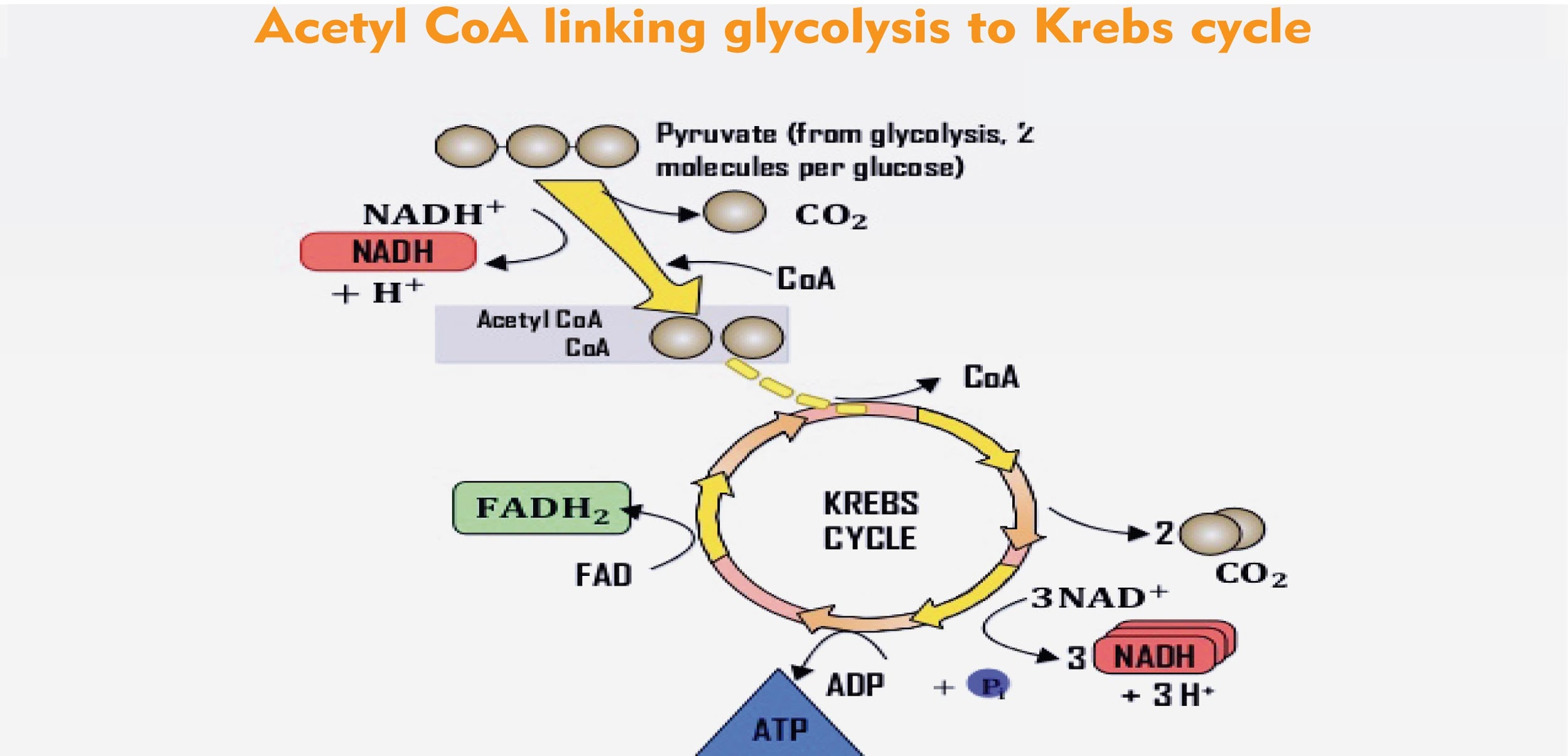
Answer
456k+ views
Hint: This is a molecule that participates in many biochemical reactions in protein, carbohydrate, and lipid metabolism. They deliver the acetyl group to the citric acid cycle for the oxidation to generate energy.
Complete answer:
Acetyl-CoA is a molecule that takes part in many biochemical reactions. It is generated through the breakdown of both carbohydrates (by glycolysis) and lipids (by β-oxidation). It then enters the citric acid cycle within the mitochondrion by combining with oxaloacetate to make citrate, which is the initiative of the citric acid cycle or Krebs’s cycle. Its main function is to provide the acetyl group to the citric acid cycle (Krebs cycle) to be oxidized for energy production.
Additional Information
-In the Krebs cycle, all aerobic organisms release stored energy through the oxidation of acetyl-CoA derived from carbohydrates, fats, and proteins.
-Adenosine triphosphate (ATP) is a compound and hydrotrope. They give energy to drive many processes in living cells, e.g. contraction, and chemical synthesis.
-Nicotinamide adenine dinucleotide (NAD) may be a cofactor that's central to metabolism. Found altogether in living cells, NAD has been named a dinucleotide as it is made up of two nucleotides joined through their phosphate groups.
-Malic acid is a dicarboxylic acid that is produced by all living organisms. It is donated to the sour taste of fruits and is used as a food additive.
So, the correct answer is ‘Acetyl-CoA’.
Note:
Konrad Bloch and Feodor Lynen were awarded the 1964 Nobel Prize for discoveries linking acetyl-CoA and fatty acid metabolism. At high glucose levels, the acetyl-CoA is produced through glycolysis. At low glucose levels, the assembly of acetyl-CoA is linked to β-oxidation of fatty acids.

Complete answer:
Acetyl-CoA is a molecule that takes part in many biochemical reactions. It is generated through the breakdown of both carbohydrates (by glycolysis) and lipids (by β-oxidation). It then enters the citric acid cycle within the mitochondrion by combining with oxaloacetate to make citrate, which is the initiative of the citric acid cycle or Krebs’s cycle. Its main function is to provide the acetyl group to the citric acid cycle (Krebs cycle) to be oxidized for energy production.
Additional Information
-In the Krebs cycle, all aerobic organisms release stored energy through the oxidation of acetyl-CoA derived from carbohydrates, fats, and proteins.
-Adenosine triphosphate (ATP) is a compound and hydrotrope. They give energy to drive many processes in living cells, e.g. contraction, and chemical synthesis.
-Nicotinamide adenine dinucleotide (NAD) may be a cofactor that's central to metabolism. Found altogether in living cells, NAD has been named a dinucleotide as it is made up of two nucleotides joined through their phosphate groups.
-Malic acid is a dicarboxylic acid that is produced by all living organisms. It is donated to the sour taste of fruits and is used as a food additive.
So, the correct answer is ‘Acetyl-CoA’.
Note:
Konrad Bloch and Feodor Lynen were awarded the 1964 Nobel Prize for discoveries linking acetyl-CoA and fatty acid metabolism. At high glucose levels, the acetyl-CoA is produced through glycolysis. At low glucose levels, the assembly of acetyl-CoA is linked to β-oxidation of fatty acids.

Recently Updated Pages
Who among the following was the religious guru of class 7 social science CBSE

what is the correct chronological order of the following class 10 social science CBSE

Which of the following was not the actual cause for class 10 social science CBSE

Which of the following statements is not correct A class 10 social science CBSE

Which of the following leaders was not present in the class 10 social science CBSE

Garampani Sanctuary is located at A Diphu Assam B Gangtok class 10 social science CBSE

Trending doubts
A rainbow has circular shape because A The earth is class 11 physics CBSE

Which are the Top 10 Largest Countries of the World?

Fill the blanks with the suitable prepositions 1 The class 9 english CBSE

Which of the following was the capital of the Surasena class 6 social science CBSE

How do you graph the function fx 4x class 9 maths CBSE

The Equation xxx + 2 is Satisfied when x is Equal to Class 10 Maths

Give 10 examples for herbs , shrubs , climbers , creepers

Difference between Prokaryotic cell and Eukaryotic class 11 biology CBSE

Who was the first Director General of the Archaeological class 10 social science CBSE




